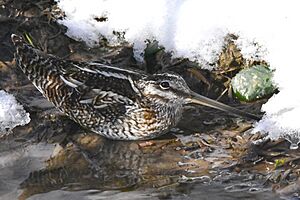Solitary snipe facts for kids
Quick facts for kids Solitary snipe |
|
|---|---|
 |
|
| Conservation status | |
| Scientific classification |
The solitary snipe (Gallinago solitaria) is a special type of bird called a wader. Waders are birds that often walk in shallow water or mud to find food. This bird is found in a large area called the Palearctic, which stretches from places like northeast Iran all the way to Korea and Japan.
Contents
What Does the Solitary Snipe Look Like?
This bird is quite big and heavy for a snipe, growing to about 29 to 31 centimeters long. It has a strong body and legs that are a bit short for a wader.
Colors and Patterns of the Solitary Snipe
The top part of its body, its head, and neck are covered in brown stripes and patterns. It also has whitish edges on its feathers, which create cool lines down its back. Its face is mostly white. The chest is a reddish-brown color, and its belly is white with brown stripes on the sides.
Beak, Legs, and Flight
The solitary snipe has a long, straight, and thin beak that is brown and black. Its legs and feet are yellowish-green or yellowish-brown. Both male and female snipes look similar, but females are usually a bit bigger.
Different Types of Solitary Snipes
There are two types, or subspecies, of the solitary snipe. The most common one is called G. s. solitaria. The other one, G. s. japonica, has more red and less white on its upper body. We don't know exactly where G. s. japonica breeds, but it spends its winters in Japan.
Sounds the Solitary Snipe Makes
When a solitary snipe takes off, it makes a rough kensh sound. When it's trying to attract a mate, it has a loud chok-a-chok-a call that can be heard from far away. This bird also has a slow and heavy way of flying.
Where Do Solitary Snipes Live?
The solitary snipe lives in the mountains of eastern Asia. You can find them in places like eastern Russia, Kazakhstan, Kyrgyzstan, and Mongolia.
Solitary Snipe's Home and Travel
Many of these birds stay in the high mountains all year round. They might only move to lower areas if the weather gets very cold and snowy. However, some solitary snipes are migratory. This means they travel long distances to warmer places for winter. They might fly to northeast Iran, Pakistan, northern India, Bangladesh, eastern China, Korea, Japan, and Sakhalin.
How Do Solitary Snipes Live?
These snipes like to breed in mountain bogs and river valleys that are above the tree line. This is usually at very high altitudes, from about 2,400 meters up to 5,000 meters. When they are not breeding or when they are migrating, they can be found in similar wet areas like marshes and swamps at lower altitudes.
Building a Nest
The solitary snipe builds a nest that looks like a shallow bowl. It's made from dry grass and is usually hidden in a thick bunch of grass or sedges in the drier parts of its wetland home.
Amazing Aerial Displays
These birds have a cool way of showing off in the air! They fly high in circles, then suddenly dive down very fast. As they dive, they make a special "drumming" sound. This sound is made by their outer tail feathers vibrating in the air.
What Do Solitary Snipes Eat?
The solitary snipe finds its food by pushing its long beak deep into the mud. It looks for small creatures like insects and worms. They also eat seeds and other plants.
Hiding and Escaping
Solitary snipes are usually quite calm and let people get close. But if they feel scared, they will crouch down. Their brown and patterned feathers help them blend in perfectly with the marsh plants, making them very hard to see. If they are startled and fly away, they usually fly a short, slow distance before dropping back into the marsh to hide again.
Images for kids




